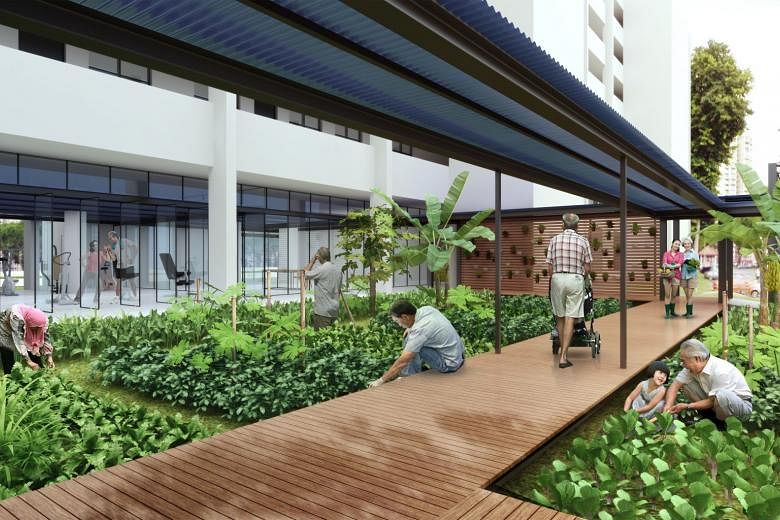SINGAPORE - Who says spaces for the elderly have to look like void deck daycare centres?
An upcoming facility in Chong Boon, Ang Mo Kio, will offer elderly residents a place to exercise, have a health check or just hang out, at a site that stretches the bounds of the usual senior centres.
The "community pocket" at Block 433, Ang Mo Kio Avenue 10, features a glass-partitioned void deck space which extends out to pavilions and sheltered boardwalks with garden plots on either side.
The size of two and half basketball courts, the facility is designed for seniors to mingle with their neighbours and pursue their interests.
To be run by Touch Community Services, it will be ready by the end of 2018. Its $900,000 set-up costs will be funded by philanthropic group Lien Foundation and Touch.
The facility is one of 10 ideas presented in a book on designs for senior living.
Lien Foundation, an advocate for quality pre-school and eldercare services, has commissioned local firm Colours to come up with 10 innovative senior living concepts and locate them in underused and overlooked plots of land in Singapore.
The ideas cover lifestyle spaces and elderly care centres, as well as alternative residential living options such as assisted living facilities.
"Senior living is not just about building care centres," said Lien Foundation chief executive Lee Poh Wah. "It is about providing an enabling physical environment and opportunities to work, play, exercise and pursue passions and avoid institutional care for as long as possible."
The ideas in the book, Second Beginnings, propose using the spaces under elevated MRT tracks, empty warehouses or stadiums to support the social or residential needs of the elderly.
Landscape architect Kang Fong Ing from Colours said its designers were inspired by how people, especially migrant workers, make use of vacant spaces under MRT tracks to play music, have lunch or haircuts.
Mr Lee hopes eldercare operators, property developers and the Government will "shamelessly plagiarise" the designs, which include building accommodation for the elderly in unlikely places such as university campuses, stadiums and gardens.
The release of the book comes as the Government studies how assisted living facilities can be offered. Such facilities allow seniors with physical or mental health needs and varying degrees of mobility to retain their independence by living at home or in the community, instead of a more institutionalised setting such as a nursing home.
Ms Kang said: "With this book, we hope to promote the idea that there is a choice between ageing-in-nursing-home and ageing-at-home, that is - ageing-in-community."
The designers said they went all over the island to scout for locations to site their senior living concepts.
In 2014, Lien Foundation asked architects to design pre-schools situated at unusual locations, hoping that operators and government agencies would consider the plans.
"We see some of the ideas from the pre-school book emerge in different places. There is now a pre-school on top of a multi-storey carpark and one near to the beach and forest in Sentosa. Another will open at Sengkang Riverside Park this year," said Mr Lee.
"Whether or not these ideas were taken from the book, we are glad to see the higher degree of experimentation in the choice of locations from these preschools," he added.
That is why Lien is partnering Touch to develop the community facility in Ang Mo Kio.
"We hope to create an environment that is safe and stimulating for the seniors," said Mr Kavin Seow, senior director of the elderly group at Touch Community Services.
Touch has worked with the Town Council and Family Service Centre in the area to make the necessary corrections, such as installing anti-slip tiles, for a more conducive environment for the seniors.
Touch and the designers said they had looked at examples in other countries and also consulted the elderly through workshops to come up with the ideas.
Ms Wang Jing, assistant director of counselling and coaching at Tsao Foundation, said it was good to involve the elderly in designing spaces meant for them.
Giving the thumbs up to the ideas in the book, she said: "Those look like very creative approaches to enhancing inclusiveness and the participation of older persons and to optimising land use."


